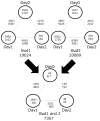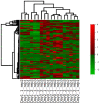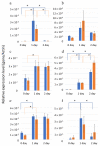Detection of Transcription Factors Related to Axillary Bud Development after Exposure to Cold Conditions in Hexaploid Chrysanthemum morifolium Using Arabidopsis Information
- PMID: 37687366
- PMCID: PMC10490133
- DOI: 10.3390/plants12173122
Detection of Transcription Factors Related to Axillary Bud Development after Exposure to Cold Conditions in Hexaploid Chrysanthemum morifolium Using Arabidopsis Information
Abstract
Chrysanthemum is one of the most commercially used ornamental flowering plants in the world. As chrysanthemum is self-incompatible, the propagation of identical varieties is carried out through cuttings rather than through seed. Axillary bud development can be controlled by changing the temperature; for instance, axillary bud development in some varieties is suppressed at high temperatures. In this study, we focused on the simultaneous axillary bud growth from multiple lines of chrysanthemum upon changing conditions from low to normal temperature. Transcriptome analysis was conducted on the Chrysanthemum morifolium cultivar 'Jinba' to identify the important genes for axillary bud development seen when moved from low-temperature treatment to normal cultivation temperature. We performed RNA-Seq analysis on plants after cold conditions in two-day time-course experiments. Under these settings, we constructed a transcriptome of 415,923 C. morifolium and extracted 7357 differentially expressed genes. Our understanding of Arabidopsis axillary meristem development and growth showed that at least 101 genes in our dataset were homologous to transcription factors involved in the biological process. In addition, six genes exhibited statistically significant variations in expression throughout conditions. We hypothesized that these genes were involved in the formation of axillary buds in C. morifolium after cold conditions.
Keywords: Chrysanthemum morifolium; RNA-Seq; axillary bud; transcription factor.
Conflict of interest statement
The authors declare no conflict of interest.
Figures






References
-
- Yang D.H., Yun P.Y., Park S.Y., Plaha P., Lee D.S., Lee I.S., Hwang Y.S., Kim Y.A., Lee J.S., Han B.H., et al. Cloning, characterization and expression of a Lateral suppressor-like gene from chrysanthemum (Dendranthema grandiflorum Kitamura) Plant Physiol. Biochem. 2005;43:1044–1051. doi: 10.1016/j.plaphy.2005.10.005. - DOI - PubMed
-
- Jiang B., Miao H., Chen S., Zhang S., Chen F., Fang W. The Lateral Suppressor-Like Gene, DgLsL, Alternated the Axillary Branching in Transgenic Chrysanthemum (Chrysanthemum × morifolium) by Modulating IAA and GA Content. Plant Mol. Biol. Rep. 2010;28:144–151. doi: 10.1007/s11105-009-0130-3. - DOI
LinkOut - more resources
Full Text Sources
Research Materials

